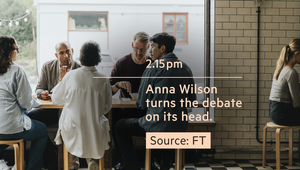
Sonic Branding: From Stone Age to Today

The first example of human sonic branding occurred around 5,500 BC. Perhaps.
The first cavewoman (or man) took two bones, a hollow tree stump with an animal hide stretched across, and rhythmically beat out the name of her tribe. I imagine it sounded a bit like the rhythm of we-buy-any-car-dot-com. A tribe far away across the valley would have been the audience. They would listen, know exactly what the rhythm meant and correctly attribute where it came from. Perhaps they would have replied with their own animal skin sonic signature, something like the rhythm of ‘You’re-gonna-get-your-f***-**g-head-kicked-in’.

The next big leap may have been the monks in the 11th century with their own sonic logos. Or chants. They were masters of the craft and knew how to influence and affect their wider audience with music incredibly well. Complex layers of emotions and meanings could be communicated with only a small group of voices. However, at that time music notation was simple and omitted basic things like tempo, dynamics and note duration. I’m sure with hilarious results.
Enter: Guido of Arezzo, Benedictine monk. He pioneered modern music notation. Previously open to all manner of wild misinterpretations, the new 'Guido Hand' method of notating music could be easily written on parchment. More importantly, it was easily taught, and read, and understood and… sung… And communicated... Hallelujah!

These manuscripts could now be copied - by hand - and disseminated (an early form of broadcasting) with other Monkly communities. Up and down the land we could now understand and sing, and listen to the same uniform message. Everyone could sing from the same hymn sheet, so to speak. Very handy for unifying the brand sound. The wider audience could hear and correctly attribute who the message was from. And what it meant. Perhaps the first audio brand bible?
And what incredible longevity.
Fast forward another 11,000 years and these are interesting times again! With all the recent audience insight research - specifically in the advertising music and sonic branding space, it’s now easier for us creative types to share our vision with this second group. You can now drill down and query megabytes of real-human-benchmarked-audience-insight data. In some myopic detail. And, audibly demonstrate to clients how examples of ‘happy’, or ‘luxurious’ or ‘bold’ or ‘caring’ actually sound…In any combination. In any genre. Great for getting all the parties aligned when starting to think about brand music. However, I’ve found music commissioners fall into two categories:
The first: Creatives and Brand Managers who are completely at ease talking about, briefing and judging how your music might work. Even if they are ‘unmusical’ they can generally still emote, describe or gesticulate.
… And the second, smaller group: They feel totally unqualified and uncomfortable talking about music. The idea of briefing a music agency terrifies them. They’d much rather pass the buck to someone else. Way too scary. However this group, invariably tend to have the final say-so, and hold the purse strings. And quite rightly, need more convincing. This is your time now!
We’ve seen a massive increase in music testing too. Insight technology, previously the domain of record companies for years now well and truly embedded in our process today. It’s important not to get too carried away. The homogenising swarm of blandness should be kept at bay. Originality, character and creativity do stand out. That takes risk and creative flair too. It’s our job to make sure there is plenty of room for this.
Our cavewoman would be dumbfounded. Looking at brands who use sonic branding today: Interestingly, rhythmic sonic logos are popular with younger brands. The monks would be pleased too. Logos with an arc or wave-shaped melodies are the most common. Of course, creating brand sound is not quite as simple. Not by a long way! However, definitely, time to stand out and be creative!
Toby Jarvis is founder of London music agency - A-MNEMONIC. Together with Exec producer Rob Dunham, they’ve created brand sound for Pago FX, Getir, TalkTalk, The Guardian, Bubu. Possibly the only music producers to turn a 5” sonic logo into a number 1 album track with “Theme from Love Island”.















